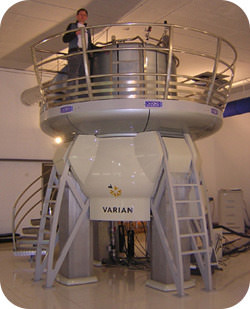9.18 凡德瓦尔部队
章节大纲
-
How To Keep It Cool?
::如何保持它凉爽?Magnetic imaging (NMR) devices use nitrogen to cool the superconducting magnets. Nitrogen is a at room temperature and liquefies at -195.8°C. Its neighbor on the periodic table (oxygen) boils at -182.95°C. The interactions between nitrogen molecules (N 2 ) are weaker, so the boiling point is lower. Interactions between non- depend on the degree of fluctuation within the molecule.
::磁成像(NMR)装置使用氮来冷却超导磁铁。氮在 -195.8°C时处于室温和液化状态。其相邻的周期表(氧)在 -182.95°C时沸腾。氮分子(N2)之间的相互作用较弱,因此沸点较低。不取决于分子内波动程度的相互作用。Van der Waals Forces
::范德瓦尔部队The first type of intermolecular force we will consider are called van der Waals forces, after Dutch chemist Johannes van der Waals (1837-1923). Van der Waals forces are the weakest intermolecular force and consist of dipole-dipole forces and dispersion forces.
::我们将考虑的第一种分子力量是范德瓦尔部队,以荷兰化学家约翰内斯·范德瓦尔(1837-1923年)为名,范德瓦尔部队是最弱的分子力量,由二极力量和分散力量组成。Dipole-Dipole Forces
::二极-二极力量Dipole-dipole forces are the attractive forces that occur between polar molecules. A molecule of hydrogen chloride has a partially positive hydrogen and a partially negative chlorine atom. In a collection of many hydrogen chloride molecules, they will align themselves so that the oppositely charged regions of neighboring molecules are near each other.
::二极力量是极分子之间产生的诱人力量。 氯化氢分子有部分正氢和部分负氯原子。 在众多氯化氢分子的集合中,它们会联合起来,使相邻的电荷分子区域相互接近。Dipole-dipole forces are a result of the attraction of the positive end of one dipole to the negative end of a neighboring dipole.
::dipole-dipole 力量是将一个顶点的正端吸引到相邻的顶点的负端的结果。Dipole-dipole forces are similar in nature, but much weaker than .
::二极力量性质相似,但比二极力量弱得多。London Dispersion Forces
::伦敦分散部队Dispersion forces are also considered a type of van der Waals force and are the weakest of all intermolecular forces . They are often called London forces after Fritz London (1900-1954), who first proposed their existence in 1930. London dispersion forces are the intermolecular forces that occur between atoms and between nonpolar molecules as a result of the motion of electrons.
::分散力量也被视为一种范德瓦尔力量,是所有分子间力量中最弱的力量,通常被称为弗里茨伦敦(1900-1954年)之后的伦敦部队,后者最初提出于1930年存在。 伦敦分散力量是原子之间和非极分子之间因电子运动而出现的分子间力量。The electron cloud of a helium atom contains two electrons, which can normally be expected to be equally distributed spatially around the nucleus . However, at any given moment the electron distribution may be uneven, resulting in an instantaneous dipole . This weak and temporary dipole subsequently influences neighboring helium atoms through electrostatic attraction and repulsion. It induces a dipole on nearby helium atoms (see Figure ).
::原子的电子云中含有两种电子,通常可以预期在空间上平均分布于核周围。然而,在任何特定时刻,电子分布可能不平衡,导致瞬时的极极极。这种微弱和暂时的极极极极极随后通过静电吸引和反射影响邻近的原子。它诱发附近原子的极极极(见图 )。A short-lived or instantaneous dipole in a helium atom.
::原子中的短寿命或瞬时二头肌。The instantaneous and induced dipoles are weakly attracted to one another. The strength of dispersion forces increases as the number of electrons in the atoms or nonpolar molecules increases.
::随着原子或非极分子中电子数量的增加,分散力量的强度会增加。The halogen group consists of four that all take the form of non-polar diatomic molecules. Table shows a comparison of the and boiling points for each.
::卤素组由四组组成,四组都以非极地二亚原子分子的形式出现,表格比较了每种分子的沸点和沸点。Melting and Boiling Points of Molecule Total Number of Electrons Melting Point (°C) Boiling Point ( °C) Physical State at Room Temperature F 2 18 -220 -188 gas Cl 2 34 -102 -34 gas Br 2 70 -7 59 liquid I 2 106 114 184 solid The dispersion forces are strongest for iodine molecules because they have the greatest number of electrons. The relatively stronger forces result in melting and boiling points which are the highest of the halogen group. These forces are strong enough to hold iodine molecules close together in the solid state at room temperature. The dispersion forces are progressively weaker for bromine, chlorine, and fluorine and this is illustrated in their steadily lower melting and boiling points. Bromine is a liquid at room temperature, while chlorine and fluorine are gases, whose molecules are much further apart from one another. Intermolecular forces are nearly nonexistent in the gas state, and so the dispersion forces in chlorine and fluorine only become measurable as the temperature decreases and they condense into the liquid state.
::对碘分子来说,扩散力最强,因为它们拥有最多的电子。相对强大的力量导致熔点和沸点,而热点是卤素组中最高的。这些力量足够强大,足以将碘分子紧紧地聚集在一起,在室温下,可以将室温温度控制在固体状态中。对于溴、氯和氟素来说,扩散力越来越弱,这一点可以从它们不断降低的熔点和沸点中看出。溴在室温中是一种液体,而氯和氟素则是气体,其分子彼此之间距离要远得多。中间分子力量在气态中几乎不存在,因此氯和氟的分散力量只有在温度下降和凝聚到液态时才能被测量。Why does water form droplets? Hint: it has to do with the interactions between water molecules. Try out this simulation to learn more:
::为什么水会形成滴子?提示:它与水分子之间的相互作用有关。尝试这个模拟来学习更多:Summary
::摘要-
Van der Waals forces are weak interactions between molecules that involve dipoles.
::Van der Waals的动力是分子之间微弱的相互作用,其中涉及低极分子。 -
Polar molecules have permanent dipole-dipole interactions.
::极分子具有永久性的二极相互作用。 -
Non-polar molecules can interact by way of London dispersion forces.
::非极分子可以通过伦敦分散力量相互作用。
Review
::回顾-
What attractive forces develop between polar molecules?
::极分子之间有哪些有吸引力的力量? -
What creates London dispersion forces?
::伦敦的分散力量是什么? -
Are London dispersion forces permanent or temporary?
::伦敦分散军是永久的还是临时的? -
Are the dispersion forces for Cl
2
stronger or weaker than the ones for Br
2
?
::Cl2的分散力量比BR2的强还是弱?
-
Van der Waals forces are weak interactions between molecules that involve dipoles.


